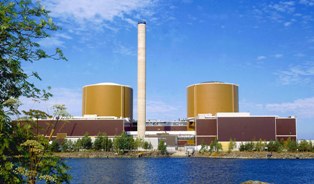Nuclear and hydro power plants in Finland are to be taxed to reduce company profits that result from competitive operation in a market with carbon trading.
A cabinet decision yesterday will lead to a government proposal for a 'windfall' tax on all low-carbon generating capacity built before the Kyoto Protocol of 1997. This will touch on the profitability of all four nuclear power units now operating in the country.
Exceptions to the state tax will be the forms of power currently promoted by government: wind power, small hydro and combined heat and power.
 |
Loviisa 1 and 2 should partially avoid the tax due to upgrades made after the 1997 Kyoto Protocol
Nuclear taxes
In Belgium, Electrabel is fighting a government move to force nuclear operators to pay a €250 million 'contribution' to the state budget. The government says this is not a tax, but Electrabel disagrees and in recent days has launched an appeal to the Belgian constitutional court over the matter. |
Nevertheless, the Finnish government said that applying a tax of between €1 and €10 per MWh to the 2182 MWe of original nuclear capacity as well as about 3000 MWe of hydro will bring in between €33 million and €330 million per year.
Rationale
Nuclear and hydro share several similarities apart from both being low-carbon. Among these are reliability, predictability and low marginal cost as key operational benefits. However, these qualities have been cited as the main reasons for imposing the new tax.
The Finnish government said that the price of power in the Nordic market varies according to the cost of extra power production at the most expensive plant. "In a system based on marginal cost pricing, production technologies with lower prices, hydro and nuclear power in the Nordic market in particular, produce significant economic advantages."
The government said that this advantage, together with the fact that nuclear and hydro plants avoid the varying costs of carbon trading in the EU's Emissions Trading Scheme, had resulted in "unearned income."
Fortum reacted quickly, stating: "The very idea of the emissions trading scheme was to direct investments to emissions-free power production. The emissions cost is a steering mechanism; producers who emit will pay and producers who don't will benefit. A special hydro and nuclear tax would work against that idea and would, in fact, punish CO2-free production."
The company also said that the tax "would increase production costs and thus electricity prices," but the government denied the tax would have a "direct influence" on prices.





_63865.jpg)
_18570.jpg)
_16159.jpg)





